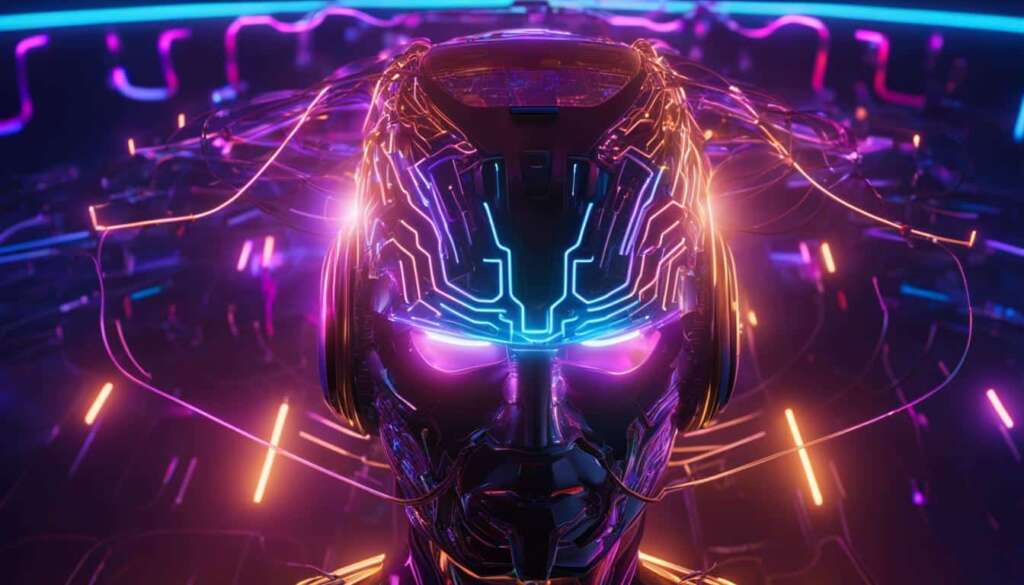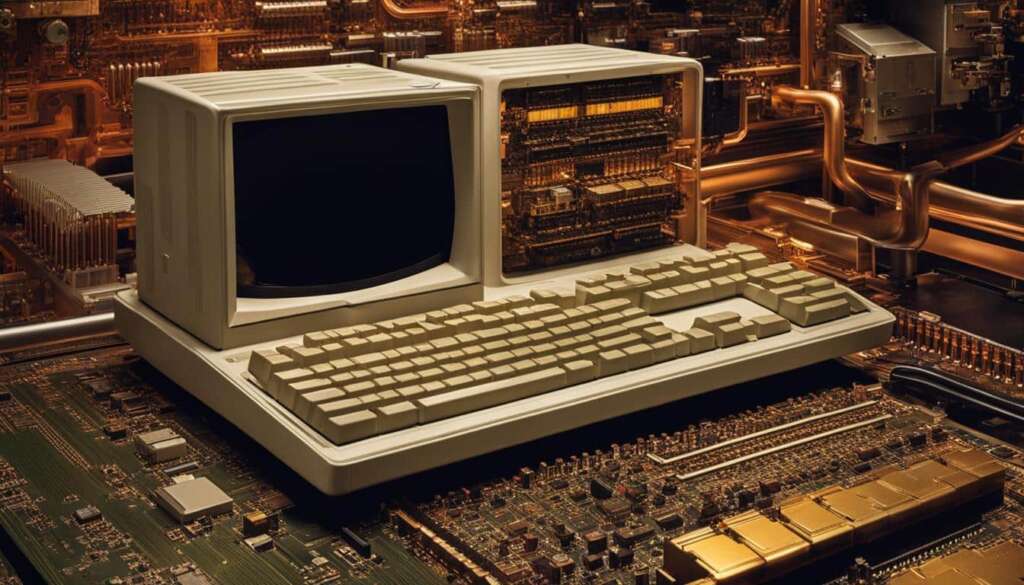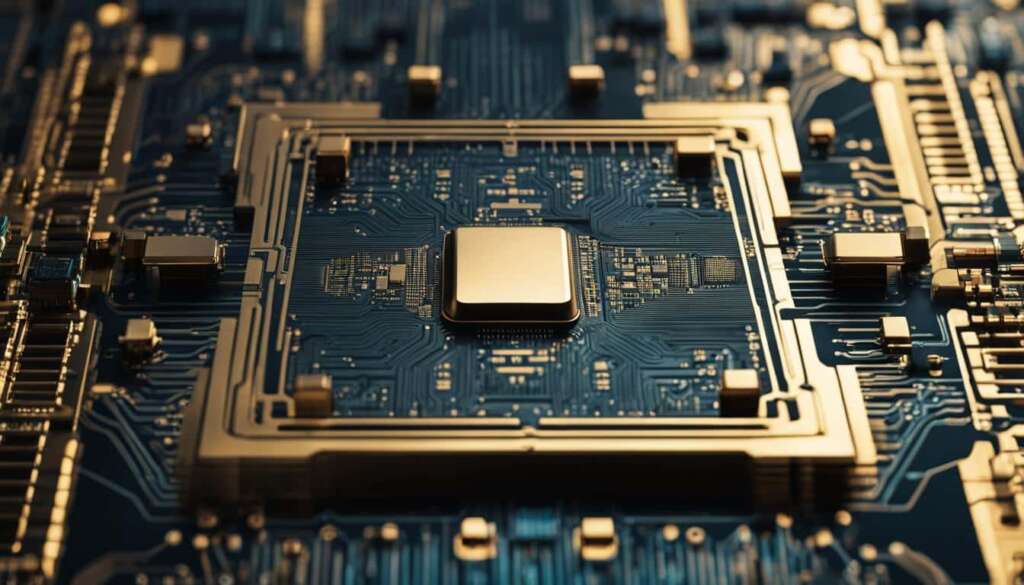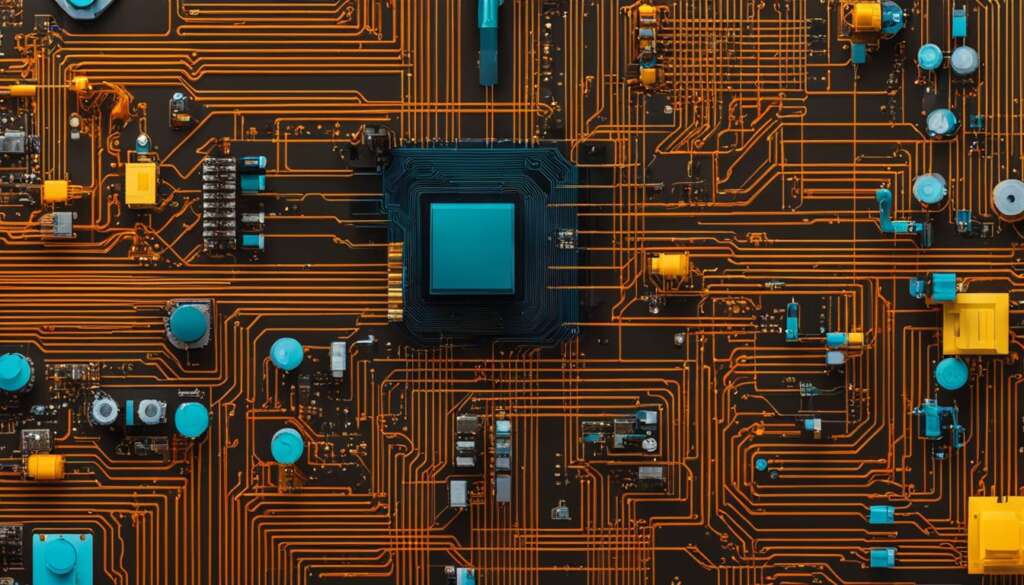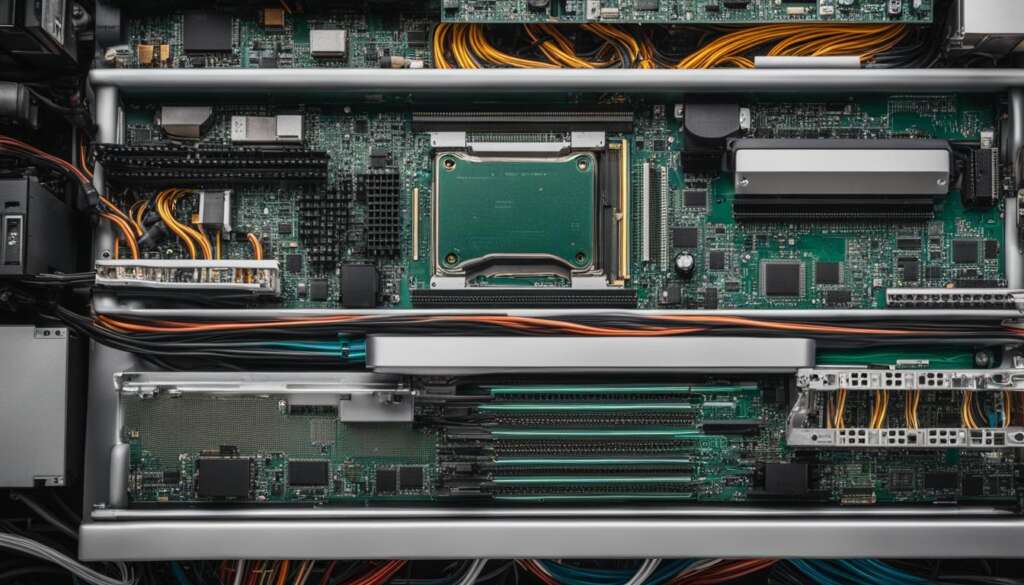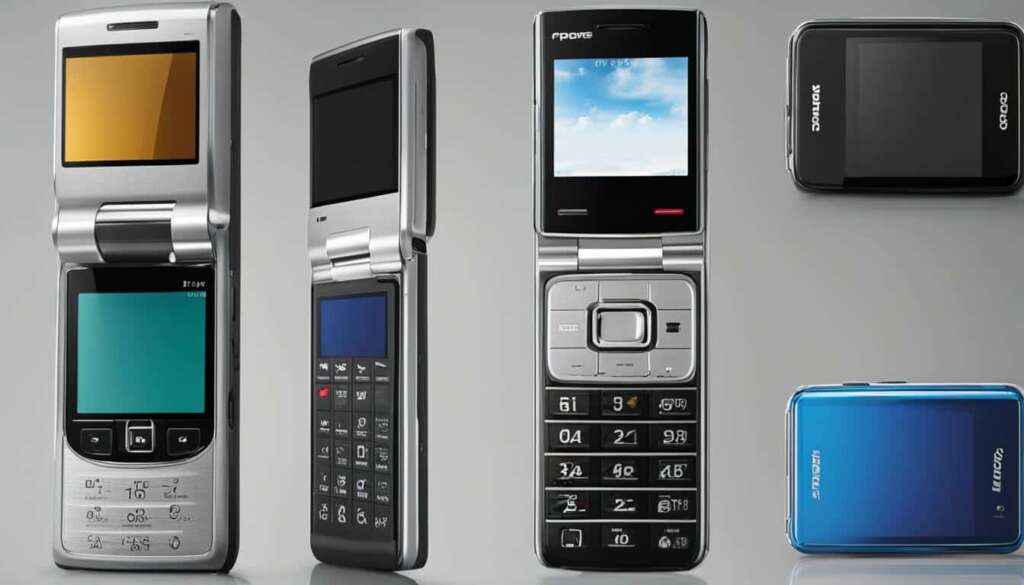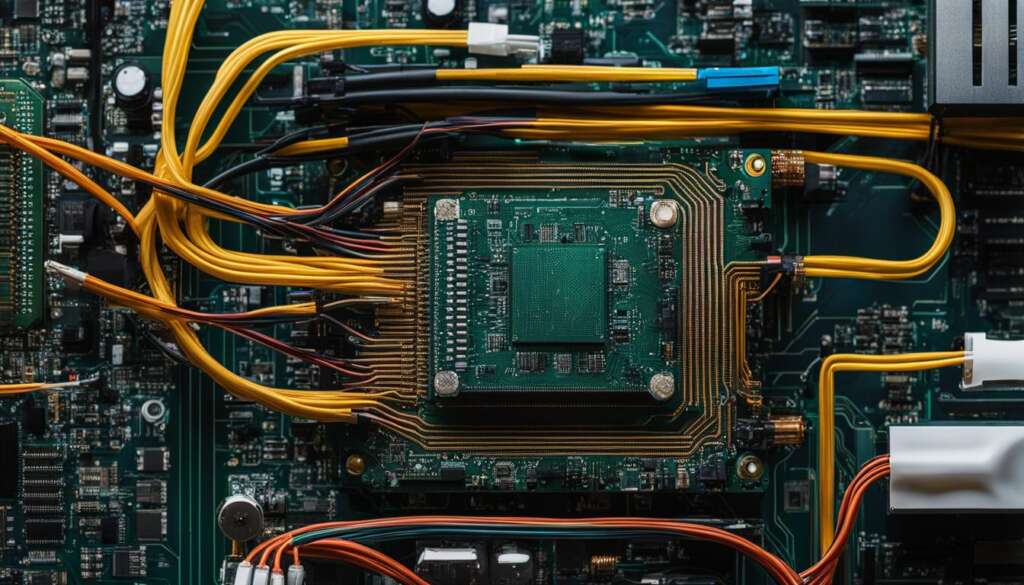Table of Contents
Virtual reality (VR) has become an increasingly popular technology, offering immersive experiences beyond gaming. One of the key factors driving the advancement of VR is the continuous development of processors and their capabilities. The evolution of VR technology has led to significant improvements in the virtual reality processor, also known as the VR chip.
The virtual reality processor plays a crucial role in enhancing VR technology and improving the overall VR experience. Processor advancements have led to significant improvements in virtual reality processing speed, graphics processing, and system performance. Innovations in processor architecture have allowed for more efficient and realistic rendering of VR environments and interactions.
With each new generation of processors, VR technology becomes more powerful, enabling developers to create more visually stunning and immersive experiences. The increased processing power also allows for smoother gameplay and reduced latency, enhancing the overall sense of presence in virtual environments.
Furthermore, processor innovations have contributed to the expansion of VR beyond gaming. Industries such as healthcare, education, and workforce training have leveraged the power of VR to provide realistic simulations and immersive training experiences. These applications require advanced processors to deliver the level of detail and interactivity necessary for effective training.
As VR technology continues to evolve, so do the demands placed on processors. The future holds promising advancements in processor technology, including improvements in haptics and biometric feedback. These developments will further enhance the immersive and realistic nature of VR experiences, pushing the boundaries of what is possible in virtual reality.
In conclusion, processor developments have played a critical role in advancing VR technology and expanding its applications. The continuous innovation in VR processors has led to significant improvements in virtual reality processing speed, graphics processing, and overall system performance. As VR technology continues to evolve, we can expect even more exciting developments in processor architecture, haptics, and biometric feedback, further enhancing the immersive potential of VR experiences.
The Evolution of VR Technology
VR technology has undergone remarkable transformations since its inception. From the early bulky and expensive headsets to the current immersive experiences, VR has come a long way. Advancements in hardware and software, as well as content, have contributed to the evolution of VR technology.
In the 90s, there was a surge of interest in VR, but it was limited to niche applications. However, in the 2010s, more affordable and consumer-accessible headsets entered the market, making VR more widely available. Over the years, hardware advancements, such as improvements in computing power and display technology, have resulted in more immersive and realistic VR experiences.
Recent years have witnessed significant strides in VR technology. Standalone VR units have become popular, eliminating the need for a desktop computer or complex setup. Handheld controllers have evolved, offering more intuitive and precise control in VR environments. Innovative features like “Direct Touch” enable hands-free control, enhancing the user experience.
The evolution of VR technology has made it more portable, user-friendly, and accessible to a wider audience.
The Revolution of Standalone VR Units
One of the notable advancements in VR technology is the development of standalone VR units, such as the Oculus Quest and HTC Vive Focus. These devices incorporate all the necessary components, including built-in displays, processors, and sensors, making them self-contained and independent of external devices like gaming consoles or computers. This makes VR experiences more convenient, allowing users to immerse themselves in virtual worlds with ease.
Improvements in Hardware and Software
Advancements in hardware and software have significantly contributed to the evolution of VR technology. Computing power has increased, enabling more complex graphics rendering and smoother performance. Display technology has also improved, with higher resolutions and refresh rates, resulting in more realistic visuals and reduced motion sickness.
Software advancements have played a crucial role in enhancing VR experiences. Improved tracking technology allows for more accurate and responsive movements, making interactions in virtual environments feel more natural. Developers have also created a wide range of content, including games, educational experiences, and simulated environments, expanding the possibilities of VR technology.
Content Advancements and Experiences
Content creation has seen significant advancements in the VR landscape. From immersive games and interactive stories to virtual tours and educational applications, there is a wide range of experiences available. VR has also found applications in various industries, such as healthcare, education, and training.
Industries like healthcare leverage VR for training healthcare providers and simulating complex medical procedures, allowing for safe and realistic training experiences. In education, VR offers immersive learning environments that enhance student engagement and understanding. From virtual field trips to interactive science experiments, VR provides unique educational opportunities.
As the technology continues to evolve, VR headsets are expected to become even more sophisticated, offering higher resolutions, wider fields of view, and improved ergonomics. Furthermore, advancements in haptics and biometric feedback are likely to enhance the sense of touch and immersion, creating more realistic and interactive VR experiences.
| Advancements | Impact |
|---|---|
| Standalone VR units | Increased portability and accessibility |
| Hardware improvements | Immersive and realistic experiences |
| Software advancements | Better tracking and more responsive interactions |
| Content creation | Diverse range of immersive experiences |
| Future developments | Higher resolutions, wider fields of view, enhanced haptics, and biometric feedback |
The Expanding Role of AI in VR
Artificial Intelligence (AI) is playing an increasingly significant role in enhancing Virtual Reality (VR) experiences. The integration of AI in VR has led to advancements in various areas such as object recognition, computer vision, natural language processing (NLP), predictive analytics, usage analytics, and personalized experiences.
By leveraging AI, VR experiences have become more realistic and adaptive. AI-powered avatars can respond to user interactions in real-time, providing a sense of immersion and enhancing the overall experience. Object recognition and computer vision algorithms enable VR systems to accurately identify and interact with virtual objects, creating a more immersive environment.
“The integration of AI in VR has revolutionized training experiences. VR simulations empowered by AI provide personalized training environments and realistic interactions.”
Predictive analytics and usage analytics in VR systems allow for data-driven insights. These analytics can be used to optimize user experiences, track user behavior, and personalize content delivery. AI also enables the creation of intelligent virtual assistants within VR environments, providing users with personalized recommendations and assistance.
The expanding role of AI in VR is transforming the way we interact with virtual worlds, making experiences more immersive and personalized. As AI continues to advance, the possibilities for enhancing VR experiences are limitless, opening new avenues for industries such as healthcare, education, and entertainment.
Table: Advancements of AI in VR
| Advancements | Impact |
|---|---|
| Object recognition | Enhances interaction with virtual objects |
| Computer vision | Creates a more immersive environment |
| Natural language processing | Enables voice commands and virtual assistants |
| Predictive analytics | Optimizes user experiences through data-driven insights |
| Usage analytics | Tracks user behavior and helps personalize content |
| Personalized experiences | Delivers tailored content and recommendations |
Advancements in Content Creation
VR content creation has experienced significant advancements in recent years, empowering designers, artists, and training experts to create a wide range of immersive experiences. With the availability of user-friendly tools and VR development platforms, individuals from various industries can now unleash their creativity and bring their ideas to life in virtual reality.
From music lessons and concerts to movies and TV shows, VR content creation offers endless possibilities for entertainment. Users can dive into virtual worlds and experience their favorite media in a completely new and immersive way. Additionally, VR has proven to be a powerful tool for meditation and therapy, providing users with a transformative and calming experience.
Another area where VR content creation has flourished is in the realm of education and learning. VR-based learning experiences allow students to engage with subjects in a more interactive and experiential way. From virtual tours of historical landmarks to simulations that help reinforce complex concepts, VR is revolutionizing the way we learn.
| Experiences | Description |
|---|---|
| Music Lessons | Learn to play musical instruments in a fully immersive virtual environment. |
| Concerts | Experience live concerts and performances as if you were right in the front row. |
| Movies and TV Shows | Step into your favorite movies and TV shows and become part of the action. |
| Meditation and Therapy | Find peace of mind and relaxation through immersive meditation and therapeutic experiences. |
| Exercise | Stay fit and active with VR fitness programs that make workouts engaging and fun. |
| Learning | Enhance educational experiences through interactive simulations and virtual field trips. |
| Virtual Tours | Explore famous landmarks and travel the world without leaving your home. |
| Immersive Storytelling | Immerse yourself in captivating narratives and become part of the story. |
These advancements in VR content creation are reshaping the entertainment, education, and wellness industries, providing users with unforgettable and transformative experiences. As technology continues to evolve, we can expect even more innovative and immersive content to be created, unlocking new dimensions of storytelling, learning, and entertainment.
Industry-Specific Advancements
Virtual reality (VR) technology has revolutionized various industries, including healthcare, education, and workforce training and development. The immersive nature of VR allows for safe skills practice and realistic simulations, resulting in enhanced learning experiences and improved outcomes.
VR in Healthcare
VR has proven to be invaluable in healthcare settings, providing a safe environment for healthcare providers to practice procedures and hone their skills. Surgeons can perform virtual surgeries, allowing them to familiarize themselves with complex procedures and reduce the risk of errors during real surgeries. Furthermore, VR can be used for patient education, allowing individuals to visualize and understand their medical conditions better.
VR in Education
The use of VR in education has transformed traditional learning methods. With VR, students can immerse themselves in virtual environments that replicate real-world scenarios. This experiential learning approach enhances engagement, information retention, and critical thinking skills. For example, students studying history can explore ancient civilizations through virtual tours, while biology students can observe the inside of a human cell in a virtual environment.
VR in Workforce Training and Development
VR is revolutionizing workforce training and development by providing realistic and interactive simulations. From manufacturing to aviation, employees can practice operating machinery, handling hazardous materials, or performing complex tasks in a controlled virtual environment. This allows individuals to gain hands-on experience without the risks associated with real-life scenarios. VR-based training programs also enable companies to train employees more efficiently and cost-effectively.
Overall, VR technology has brought significant advancements to various industries. Its applications in healthcare, education, and workforce training and development have improved safety, learning outcomes, and efficiency. As VR continues to evolve and become more accessible, its potential to transform industries and provide innovative solutions remains promising.
VR Developments and Trends on the Horizon
The future of VR holds exciting possibilities as businesses and industry leaders engage with metaverse technologies. Advancements in hardware are expected to revolutionize the VR experience, with new VR headsets set to hit the market in the coming years. These new devices, such as the Meta Quest 3 and Apple Vision Pro, promise lighter weight and more sophisticated mixed reality experiences. With improved processing power and graphics capabilities, users can expect even more immersive and realistic virtual environments.
In addition to hardware improvements, haptics is a groundbreaking development that is set to enhance the sense of touch and immersion in VR. By incorporating biometric feedback into VR headsets, instructors and trainers will have access to valuable user metrics like heart rate, respiration, and stress levels. This data can be used to analyze user performance and tailor experiences accordingly, leading to more personalized and effective training sessions.
VR technology is constantly evolving, and we can expect to see new and exciting developments in the near future. From improved VR headsets to advancements in haptics and biometric feedback, the immersive and realistic nature of VR experiences will continue to expand.
As VR technology continues to advance, it is important for businesses and individuals to stay informed about the latest trends and developments. By embracing these new technologies and incorporating them into their operations, businesses can gain a competitive edge and deliver cutting-edge experiences to their customers. The future of VR is bright, and the possibilities for innovation and growth are endless.
Table: Upcoming VR Headsets
| VR Headset | Release Date | Features |
|---|---|---|
| Meta Quest 3 | 2023 | Lightweight design, mixed reality experiences |
| Apple Vision Pro | 2023 | Advanced graphics capabilities, enhanced immersion |
| HTC Vive Pro 2 | 2022 | Higher resolution display, improved comfort |
Design and Pitching in VR
VR technology is revolutionizing the way designers create and pitch their ideas in various industries. With VR, architects and designers can now showcase accurate and detailed renderings of their projects, providing clients and stakeholders with a more immersive and realistic visual experience.
One of the platforms that enable designers to transform their 3D designs into VR-compatible renderings is Yulio VR. This user-friendly tool empowers architects and designers to collaborate effectively with clients, allowing them to explore and interact with the virtual environment, gaining a better understanding of the design possibilities.
VR technology has transformed our design process. It has allowed us to create highly realistic renderings that bring our projects to life. With VR, our clients can now step into our designs and experience them in a way that was not possible before.
VR technology is not limited to architecture and design alone. Companies like Woodhouse Workspace are utilizing VR to showcase office layouts and help clients visualize the optimal utilization of space. Through mobile-compatible VR experiences, clients can explore virtual offices and make informed decisions about their future workspaces.
Table: VR Platforms for Design and Pitching
| Platform | Description |
|---|---|
| Yulio VR | A user-friendly tool that turns 3D designs into VR-compatible renderings, allowing for immersive design presentations and client collaborations. |
| Woodhouse Workspace | Utilizes VR to showcase office layouts and enable clients to virtually experience and visualize their future workspaces. |
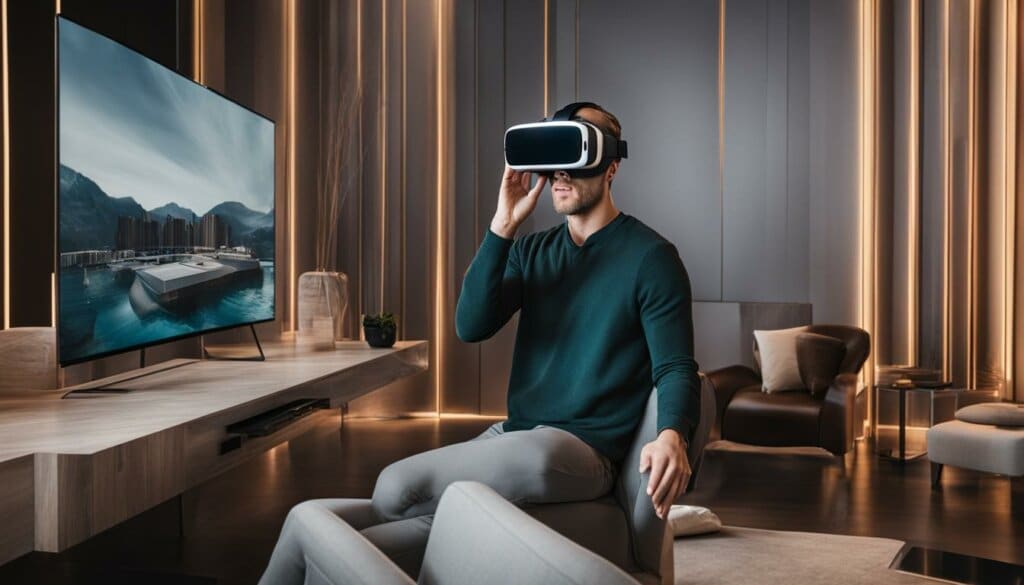
VR for Safety and Training
In the construction industry, safety is a top priority. With the advent of virtual reality (VR) technology, safety training has been taken to a whole new level. VR simulations provide workers with a realistic and immersive environment to practice machinery operations, reducing the risk of injury on the job site. Through VR training, workers can familiarize themselves with equipment controls, perform tasks in a virtual construction site, and learn how to respond to potential hazards. This interactive and hands-on approach enhances safety awareness and prepares workers for real-world scenarios.
VR simulations in construction training offer several advantages. They allow workers to experience and become comfortable with complex equipment without the need for physical presence or the risk of damage. It also provides an opportunity for repetitive training, allowing workers to refine their skills and improve their efficiency. By practicing machinery operation and safety procedures in a virtual setting, workers gain the confidence and competence necessary to perform their tasks safely on-site.
“VR training is particularly valuable for workers in remote or rural areas who may not have easy access to traditional training facilities.”
Furthermore, VR simulations can be tailored to specific construction tasks, allowing workers to practice in a controlled environment that closely mimics real-world conditions. This targeted training enables workers to identify potential hazards, understand safety protocols, and develop critical thinking skills to make informed decisions. By investing in VR for safety training, construction companies can significantly reduce the risk of accidents, enhance worker preparedness, and promote a culture of safety.
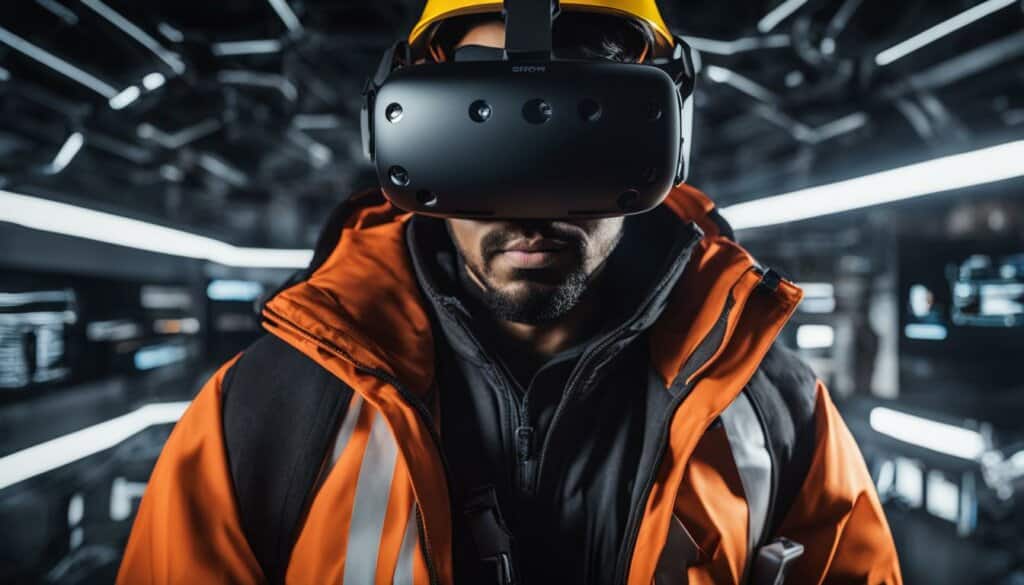
VR for Construction Training Benefits:
- Realistic and immersive environment for practicing machinery operations
- Enhanced safety awareness and hazard recognition
- Repetitive and targeted training opportunities
- Improved worker confidence and competence
- Reduced risk of accidents and injuries
| Advantages of VR for Construction Training | Traditional Training Methods |
|---|---|
| Realistic and immersive training environment | Static presentations and demonstrations |
| Hands-on practice with complex equipment | Observation of equipment operation |
| Targeted training for specific construction tasks | Generic safety lectures |
| Repetitive training opportunities | Limited practice sessions |
| Immediate feedback and assessment | Delayed evaluation and feedback |
VR for Customer Experience
Virtual reality (VR) technology has revolutionized the way customers experience properties, providing a realistic and immersive environment for potential property owners. Virtual property tours have become increasingly popular, allowing customers to visualize and explore future properties before they are built. These virtual tours provide personalized views and layouts, giving customers a comprehensive understanding of the property’s features and design.
With VR, customers can walk through virtual spaces, interact with different elements, and even make modifications to better suit their preferences. This improved property visualization helps customers make informed decisions and increases their satisfaction with the final product. By experiencing the property virtually, customers can gain a sense of how the space will look and feel, ensuring that it meets their expectations and requirements.
VR technology enhances the customer experience by allowing customers to take virtual tours of properties, providing personalized views and layouts. It improves property visualization and helps customers make informed decisions.
Benefits of VR for Customer Experience:
- Improved property visualization
- Personalized views and layouts
- Realistic and immersive experience
- Informed decision-making
By leveraging VR for customer experience, real estate developers and agents can enhance their services, attract more potential buyers, and increase customer satisfaction. The ability to virtually experience a property before it is built is a game-changer in the industry, offering a unique and interactive way to engage with customers.
Overall, VR technology has transformed the customer experience in the property market, providing a powerful tool for visualizing and exploring future properties. As VR continues to advance, we can expect even more realistic and immersive experiences, further enhancing the satisfaction of customers in their property-buying journey.
| Benefits of VR for Customer Experience |
|---|
| Improved property visualization |
| Personalized views and layouts |
| Realistic and immersive experience |
| Informed decision-making |
VR for Reducing Labor Costs and Improving Efficiency in Construction
In the construction industry, labor costs and efficiency are critical factors that can greatly impact project timelines and budgets. Fortunately, virtual reality (VR) technology has emerged as a powerful tool that can help address these challenges. By leveraging intelligent construction machinery and providing a virtual preview of work areas, VR enables construction professionals to adapt to changes, maintain timelines, and ultimately reduce labor costs.
One of the key benefits of VR in construction is the ability to utilize intelligent construction machinery. By integrating VR technology with intelligent machinery, construction tasks can be performed remotely, reducing the need for multiple workers to be physically present on-site. This not only minimizes labor costs but also improves efficiency by streamlining operations and reducing the risk of errors and accidents.
Additionally, VR provides a virtual preview of work areas, allowing site managers to visualize and plan construction activities with precision. With VR, construction professionals can virtually walk through the job site, making calculations and adjustments in real-time. This enables them to adapt to changes and make informed decisions, ensuring that projects stay on track and are completed within the specified timelines.
| Benefits of VR for Reducing Labor Costs and Improving Efficiency |
|---|
| Reduced labor costs by leveraging intelligent construction machinery. |
| Improved efficiency through streamlined operations and reduced errors. |
| Virtual preview of work areas for better planning and decision-making. |
| Adaptation to changes in real-time, maintaining project timelines. |
In conclusion, VR technology holds immense potential for reducing labor costs and improving efficiency in the construction industry. By leveraging intelligent construction machinery and providing a virtual preview of work areas, construction professionals can adapt to changes, make informed decisions, and maintain project timelines. As VR technology continues to advance, its transformative impact on the construction industry is becoming increasingly apparent, offering new possibilities for cost savings and operational excellence.
Conclusion
VR technology in construction has the potential to revolutionize the industry, making it more immersive and efficient. The transformative impact of VR can be seen in various aspects of construction, from design and pitching to safety and training. Architects and designers can benefit from VR’s ability to create accurate and detailed renderings, effectively communicating their design ideas to clients and stakeholders.
By utilizing VR simulations and training programs, construction workers can practice operating machinery in a safe and controlled environment, reducing the risk of on-site incidents and improving worker preparedness. This technology also enhances the customer experience, allowing potential property owners to view and experience future spaces before construction is complete. In turn, this leads to improved customer satisfaction and increased property sales.
Looking ahead, the future of the construction industry is set to be transformed by VR technology. It offers the potential to reduce labor costs and increase efficiency through precise planning and adaptability to changes. With VR’s immersive and realistic experiences, the way projects are designed, built, and experienced will be fundamentally altered. As construction professionals continue to embrace and innovate with VR, the industry will undoubtedly be reshaped by its transformative capabilities.
FAQ
How have processor developments enhanced virtual reality?
Processor advancements in virtual reality technology have improved processing speed, graphics processing, and overall system performance. Innovations in processor architecture have enabled more immersive and realistic VR experiences.
What is the evolution of VR technology?
VR technology has evolved over the years through hardware, software, and content advancements. This has led to more immersive experiences and the development of standalone VR headsets that eliminate the need for a desktop computer.
What role does AI play in VR?
AI enhances VR experiences through object recognition, computer vision, natural language processing (NLP), predictive analytics, usage analytics, and personalized experiences. AI-powered avatars and simulations make VR experiences more realistic and adaptive.
How has content creation in VR advanced?
VR content creation has become more accessible with user-friendly tools and development platforms. This has resulted in a wide range of experiences available, including music lessons, concerts, movies and TV shows, meditation and therapy, exercise, learning, virtual tours, and immersive storytelling.
How is VR being utilized in specific industries?
VR is being leveraged in healthcare, education, and workforce training and development. It enables safe skills practice, immersive learning experiences, and realistic simulations for training purposes.
What developments and trends can we expect in VR?
The future of VR holds promise, with new and improved VR headsets, advancements in haptics, and the integration of biometric feedback. Business leaders are actively exploring metaverse technologies to further enhance VR experiences.
How is VR being used for design and pitching?
VR is transforming the design and pitching processes by enabling accurate and detailed renderings. Designers can use VR-compatible tools to create immersive experiences, making it easier to collaborate with clients and stakeholders.
How is VR improving safety and training in high-risk industries?
VR simulations and training programs are being used to practice operating machinery and reduce the risk of on-site incidents in industries like construction. Workers can safely train in a controlled environment and troubleshoot potential issues.
How does VR enhance customer satisfaction?
VR provides virtual property tours and personalized views, allowing potential property owners to experience and visualize future spaces before construction is complete. This leads to improved customer satisfaction and informed decision-making.
How can VR reduce labor costs and improve efficiency?
By utilizing intelligent construction machinery and virtual preview of work areas, VR can reduce the need for multiple workers on-site. Real-time views of the job site conditions allow for precise planning and adaptability to changes, improving efficiency.
What is the impact of VR on the construction industry?
VR technology is transforming the construction industry, from design and pitching processes to safety training and customer satisfaction. It provides immersive and realistic experiences, improves worker preparedness, and enhances the overall construction process.

